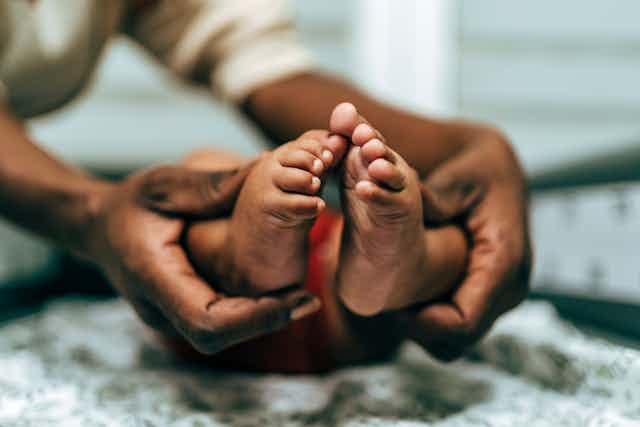The demographic profile of a country matters because it sets its development pace – it creates opportunities and presents risks. For many developing countries, the challenge is to manage a demographic profile that puts pressure on particular cohorts of people. One country that needs to manage this challenge is the Democratic Republic of Congo. Jacques Emina, who has studied demography in the country for the last two decades, unpacks the numbers.
What are the DRC’s demographic challenges? What’s driving them?
With 102 million people in 2023, the Democratic Republic of Congo is the fourth most populous country in Africa after Nigeria, Ethiopia and Egypt. It’s the 15th most populous country in the world.
It’s estimated that by 2050, the DRC will have 215 million people and join the world’s 10 most populated countries. This isn’t so surprising, given the size of the country: 2.3 million square kilometres, making it the second-largest country in Africa (behind Algeria).
The country’s population reflects higher-than-average growth compared to other countries on the continent. The DRC’s population grew by 3.3% in 2022. The continent’s average was 2.5%. The average world population growth rate was 0.8% in 2022.
The DRC’s growing population has serious consequences for the wellbeing of its people. Without policies that take account of the country’s demographic profile – a growing population and a very high number of young people versus working age people – social conditions like poverty and hunger will increase.
There are two main reasons for the high population growth: a decrease in deaths and a high number of births.
Over the past decades, the DRC has seen a consistent drop in under-five mortality, though this is still relatively high compared to the world average. In 1995, under-five mortality was estimated at 175 deaths per 1,000 births. This dropped to 87 deaths per 1,000 births in 2018. In the same year the global under-five mortality rate stood at 40 deaths per 1,000 births.
Life expectancy in the DRC has also increased from 49 years in 1995 to 62 years in 2023. The current global life expectancy is 73 years.
When it comes to numbers of births, Congolese women average 6.2 babies in their lifetimes. This is four births more than the global average of 2.3 babies.
The DRC’s fertility rate is driven by four major factors.
Firstly, cultural values encourage people to have children. Large families are celebrated. The country’s most recent demographic and health survey found that Congolese women on average wanted six children; men wanted seven.
Secondly, an early start to childbearing means more years of giving birth. More than 30% of girls in the DRC are married before they turn 18. About a quarter of young women give birth by their 18th birthday compared to 14% worldwide. And 27% of adolescent Congolese girls aged 15-19 have children.
Thirdly, very few women use contraception in the DRC. The percentage of women of reproductive age who use an effective form of modern contraception was estimated at around 7% in 2018. This was up from 4% in 2007.
The fourth factor driving population growth is the absence of a national population policy. This typically includes a set of measures designed to influence population dynamics.
What impact is this having?
The DRC’s galloping demography has several implications.
The first is a high dependency ratio. This is when there are far more economically dependent people than economically active ones because of the demographic age profile of the country. The economically active population faces a greater burden to support economically dependent people, particularly children. Children under the age of 15 account for 41.6% of the DRC’s total population. This indicates that employed people aged 15-64 bear a heavy burden amid low incomes.
The country also faces significant planning challenges. School attendance rates increased from 52% in 2001 to 78% in 2018. Nevertheless, 7.6 million children aged 5-17 are still out of school.
The DRC lags behind in other key human development measures.
It’s among the five poorest nations in the world. In 2022, 62% of Congolese (60 million people) lived under the poverty line (less than US$2.15 a day). About one in six people living in extreme poverty in sub-Saharan Africa lives in the DRC.
The country has faced political unrest and armed conflicts for six decades. The 2023 Global Peace Index – which measures the relative peacefulness of nations and regions – lists the DRC as one of the least peaceful countries in the world after Afghanistan, Yemen, Syria and South Sudan.
The country has one of the world’s highest maternal mortality ratios at 547 deaths per 100,000 live births. The global average is 223 deaths per 100,000 live births.
It’s one of the world’s hungriest countries. Its Global Hunger Index score – which measures and tracks levels of hunger globally – stands at 37.8, which is tagged as “alarming”.
What interventions are needed?
A country’s population profile can offer opportunities, or what’s known as a demographic dividend. This is when a high percentage of people are young and there are jobs for them.
But the DRC is missing out on this opportunity and will continue to do so unless it:
invests in human capital by improving its education and health systems. Most Congolese are paying out of their own pockets for healthcare. Education is free, but the system is weak due to low budget allocations.
designs a population policy to guide population dynamics. This would include policies on birth, migration and where people live. These should be linked to an integrated national development policy.
makes progress on gender equality. This should include increasing the enrolment of girls in high schools, discouraging child marriage and enabling young mothers to attend school.
improves governance and tackles corruption to promote investment in education, health and employment.
creates data systems that can underpin evidence-based policies.


